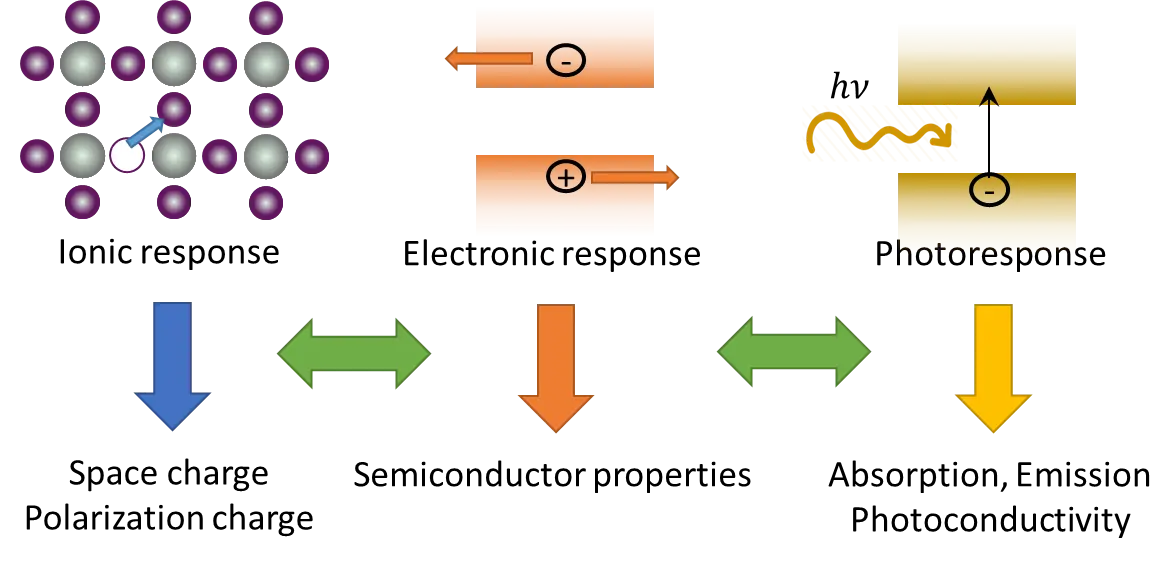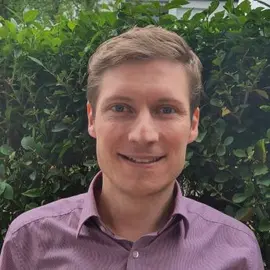Defect Engineering, Advanced Modelling and Characterization for Next Generation Opto-Electronic-Ionic Devices (OptEIon)
Description
In the project Defect Engineering, Advanced Modelling and Characterization for Next Generation Opto-Electronic-Ionic Devices (OptEIon), we investigate the interplay between electron and ionic conductivity in metal-halide perovskite semiconductors. We plan to prepare samples, characterize the transient optoelectronic response, and employ device modelling to unravel the effects of electronic and ionic defects. Finally, we aim to exploit the mixed ionic-electronic conductivity in novel devices.Perovskite solar cells have attracted grain interest because of the high efficiencies obtained (>25%) and facile preparation methods. Key to these impressive results is the high tolerance of the perovskite semiconductor versus defects. On the other hand, perovskite solar cells and LEDs suffer from instabilities, partially due to mobile ionic charges. These ions originate from crystal defects (e.g. vacancies as shown on the top left in the figure). Beyond being a stability concern, mobile ions influence the optoelectronic response of the device, e.g. by drift when a voltage is applied. This causes a belayed response that is visible, e.g. in a hysteresis when recording the current-voltage characteristics or in unconventional features in the impedance response.Within this project, we intend to further characterize the interplay between ionic and electronic conductivity. We plan to fabricate perovskite films, characterize their response to voltage and illumination stimuli and use device simulation to extract physical parameters. To gain insights into nanoscopic processes, we plan to use tipenhanced spectroscopy techniques. On the simulation side, we want to evaluate, whether and to which extent physics-based modeling can be complemented by approaches based on machine learning.The goal of this project is to control the effect of mobile ions and exploit them as modulator of loss processes in solar cells or in novel devices. A potential candidate are memristive devices. In such devices the conductivity depends on the history of the device, for instance on how much current was passed through it in the time before. Such devices might become interesting for future computing approaches such as neuromorphic computing.
Key data
Projectlead
Deputy Projectlead
Project team
Project status
ongoing, started 06/2020
Institute/Centre
Institute of Computational Physics (ICP)
Funding partner
Horizon 2020 / European Research Council ERC
Project budget
1'980'000 EUR
Publications
-
Ionic losses and gains in perovskite solar cells : impact on efficiency and stability
2025 Torre Cachafeiro, Miguel A.; Tress, Wolfgang
-
Assessing the influence of illumination on ion conductivity in perovskite solar cells
2024 Schiller, Andreas; Jenatsch, Sandra; Blülle, Balthasar; Torre Cachafeiro, Miguel Angel; Ebadi Garjan, Firouzeh; Kabir, Nasim; Othman, Mostafa; Wolff, Christian Michael; Hessler-Wyser, Aïcha; Ballif, Christophe; Tress, Wolfgang; Ruhstaller, Beat
-
Roadmap on commercialization of metal halide perovskite photovoltaics
2023 Feng, Shien-Ping; Cheng, Yuanhang; Yip, Hin-Lap; Zhong, Yufei; Fong, Patrick W.K.; Li, Gang; Ng, Annie; Chen, Cong; Castriotta, Luigi Angelo; Matteocci, Fabio; Vesce, Luigi; Saranin, Danila; Carlo, Aldo Di; Wang, Puqun; Wei Ho, Jian; Hou, Yi; Lin, Fen; Aberle, Armin G.; Song, Zhaoning; Yan, Yanfa; Chen, Xu; Yang, Yang (Michael); Syed, Ali Asgher; Ahmad, Ishaq; Leung, Tiklun; Wang, Yantao; Lin, JingYang; Ng, Alan Man Ching; Li, Yin; Ebadi Garjan, Firouzeh; Tress, Wolfgang; Richardson, Giles; Ge, Chuangye; Hu, Hanlin; Karimipour, Masoud; Baumann, Fanny; Tabah, Kenedy; Pereyra, Carlos; Raga, Sonia R.; Xie, Haibing; Lira-Cantu, Monica; Khenkin, Mark V.; Visoly-Fisher, Iris; Katz, Eugene A.; Vaynzof, Yana; Vidal, Rosario; Yu, Guicheng; Lin, Haoran; Weng, Shuchen; Wang, Shifeng; Djurišić, Aleksandra B.
-
Mixed ionic electronic conductivity in metal halide perovskites and its effects on solar cells
2022 Tress, Wolfgang
-
Device physics of perovskite solar cells
2022 Tress, Wolfgang
-
Simulating the transient luminescence of perovskite light-emitting diodes under pulsed operation
2022 Torre Cachafeiro, Miguel Angel; Kumar Kumawat, Naresh; Gao, Feng; Tress, Wolfgang
-
2D/3D hybrid Cs2AgBiBr6 double perovskite solar cells : improved energy level alignment for higher contact‐selectivity and large open circuit voltage
2022 Sirtl, Maximilian T.; Hooijer, Rik; Armer, Melina; Ebadi Garjan, Firouzeh; Mohammadi, Mahdi; Maheu, Clément; Weis, Andreas; van Gorkom, Bas T.; Häringer, Sebastian; Janssen, René A. J.; Mayer, Thomas; Dyakonov, Vladimir; Tress, Wolfgang; Bein, Thomas
-
Performance boosting polymeric finish layer for perovskite solar cells
2022 Mohammadi, Mahdi; Ebadi Garjan, Firouzeh; Tress, Wolfgang
-
Cs2AgBiBr6Double perovskites as lead‐free alternatives for perovskite solar cells?
2021 Tress, Wolfgang; Sirtl, Maximilian T.
-
The various effects of ion migration on perovskite devices
2021 Tress, Wolfgang
-
Perovskite solar cells
2021 Tress, Wolfgang
-
Characterizing perovskite solar cells and LEDs.
2021 Tress, Wolfgang
-
Physics of perovskite optoelectronic devices
2021 Tress, Wolfgang
-
The bottlenecks of Cs2AgBiBr6 solar cells : how contacts and slow transients limit the performance
2021 Sirtl, Maximilian T.; Ebadi, Firouzeh; van Gorkom, Bas T.; Ganswindt, Patrick; Janssen, René A. J.; Bein, Thomas; Tress, Wolfgang
-
Mobile ions determine the luminescence yield of perovskite light-emitting diodes under pulsed operation
2021 Kumawat, Naresh Kumar; Tress, Wolfgang; Gao, Feng
-
In-Operando PL measurements on perovskite solar cells with and without phase-segregation
2021 Ebadi Garjan, Firouzeh; Yang, Bowen; Tress, Wolfgang
-
When photoluminescence, electroluminescence, and open-circuit voltage diverge : light soaking and halide segregation in perovskite solar cells
2021 Ebadi Garjan, Firouzeh; Yang, Bowen; Kim, YeonJu; Mohammadpour, Raheleh; Taghavinia, Nima; Hagfeldt, Anders; Tress, Wolfgang
-
Device physics of perovskite solar cells
2020 Tress, Wolfgang

